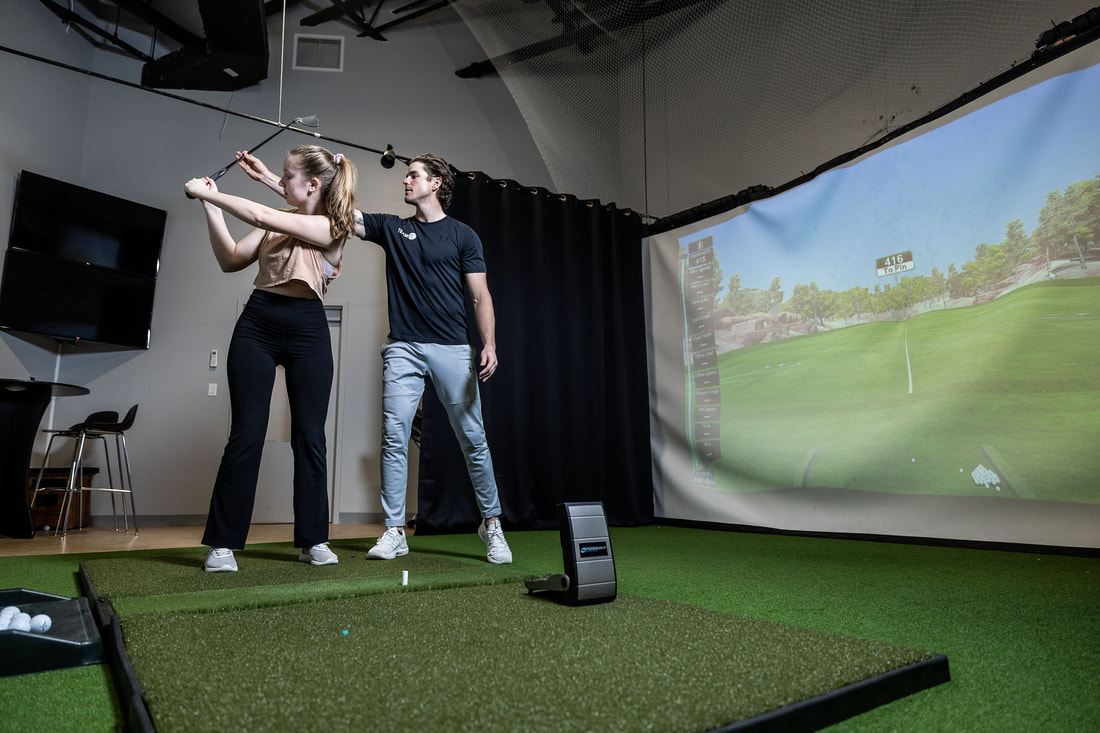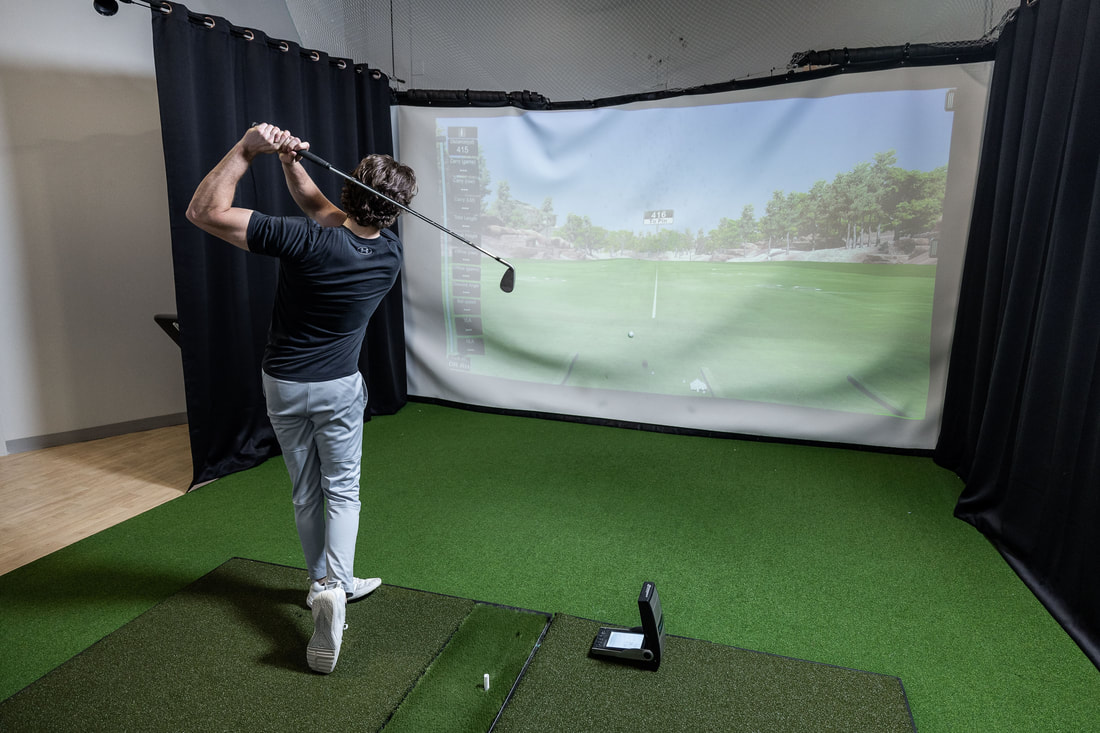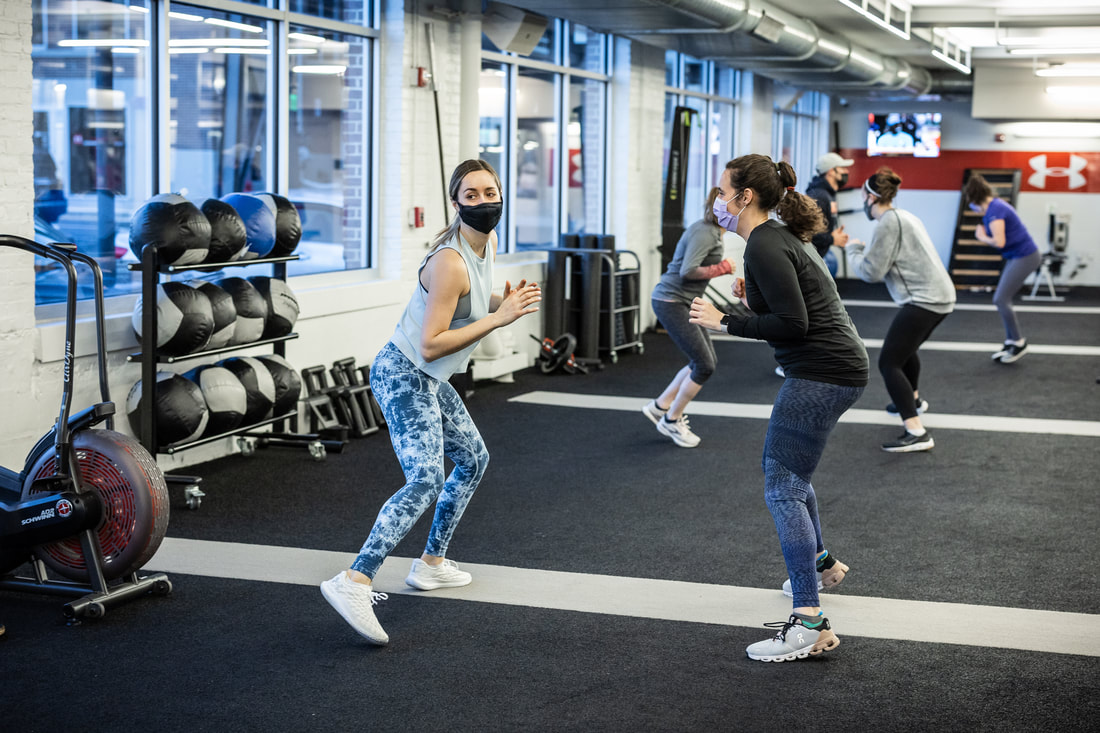|
Evan Cocke, M.S., TPI, CPT I am a strong believer that lower body and core strength are vital for golfers of all skill levels. Power is generated from the ground up through the kinetic chain. This means that your lower body needs to be utilized in order to generate a powerful and efficient golf swing. When golfers have solid lower body mechanics the rest usually falls into place.
Also, the body is protective of itself. It is not going to like being put in positions that it is not physically able to handle. The body will compensate for a lack of lower body strength by utilizing too many of the smaller, less powerful muscles that will lead to inefficiency and risk of injury through overuse. Not only will lower body/core strength help the golf swing tremendously, it will help with overall health and wellness. The common swing faults listed below have a multitude of factors. One they all have in common is a lack of lower body strength, mobility or stability. These are the top 3 swing faults I have seen as a teaching pro and a golf performance specialist. 1. Early Extension This Swing fault is one of the most commonly seen faults in all of golf. This is where you thrust your hips forward in the downswing. This causes you to raise upright and use your wrists to try to compensate at impact. This causes both hooks and blocks. One of the main causes of this swing fault is a lack of hinge or squat pattern development. The pelvis is unable to rotate around due to a lack of lower body strength and mobility. Weak glutes and poor hip internal rotation are another factor to look at. Weak abdominal core and spinal stability could also be a suspected culprit. To fix this work on hinge and squat progressions. Work your way from the basic hinge movement with a dowel rod or golf club and then start to load that motion by doing dumbbell deadlifts, romanian deadlifts and hex bar deadlifts. If you are new to squatting and have trouble getting depth then start with counter weighted squats such as goblet squats and work on getting that full range of motion. This will help with opening up the hips as well as teaching proper squat technique. These motions will teach bracing of the core/spine as well as the hinge and squat. Hinges and squats should be a central focus of all golf programs. 2. Over the Top The over the top is arguably the most commonly seen swing fault in all of golf. This is characterized by a pulling motion of the upper body causing a steep attack angle. Most of the time this will result in a huge slice but if the clubface is closed then this will result in a pull/hook. This is usually caused by an upper body dominant golf swing. A lack of lower body strength, hip mobility, ability to shift pressure, or disassociate the upper body from the lower body are all contributing factors. Things that can be done to help address this issue are strengthening of the lower body (primarily glutes) and strengthening the core muscles. Squats, hinge and bracing exercises will help tremendously. Bird Dogs, Dead Bugs, Paloff Presses, and chops are just a few of the core exercises that will help with overall core strength. Some of this can be addressed from a technical aspect. Without a strong base and the ability to disassociate it will be tough to keep consistent with swing changes because your body will instinctively try to do what is comfortable. 3. Slide The slide is characterized as too much lateral movement in the golf swing without any rotation. Lateral pressure shifts are necessary in an efficient golf swing but the lower body needs to be stable to allow the rotational/vertical aspects of the golf swing to happen. A lack of lower body strength and stability is one of the main culprits. It could be that you have the strength but do not know how to express it. There could also be a limitation with lead hip internal rotation. Like with most of these swing faults the glutes are important. Glute bridges, hip thrusts, hinges, lunge variations and squat variations are all exercises that will help aid in lower body strength and stability. Unilateral exercises and exercises that teach you to produce and absorb force will help as well. Single leg hops/lands, lateral lunges, lateral bounds, and speed skaters are a few examples. Medicine ball variations are some of my favorites. Utilize a split stance to enhance your slams/rotations. This will aid in feeling unilateral stability through a dynamic movement. In Summary TPI movement screens will be helpful in figuring out where your individual limitations lie and why these swing faults might be happening. Working with a strength and conditioning coach or TPI certified instructor will allow you to take the guesswork out of things. They will be able to pinpoint your limitations in movement or strength based off of certain screens and then will be able to devise a plan to address those issues. If you already have a substantial amount of lower body strength but do not know how to express that strength then it will require a more targeted approach focusing on specific exercises based on your individual limitations. There are a variety of different exercises that will be able to get you to the same result. It is about finding the best ones for you that give the greatest rate of return. In general, if you have lower body/core strength the golf swing will seem a lot easier. It will be easier to make the swing changes you need with your PGA professional. Your body will be able to handle certain positions with ease and your body awareness will improve. Your risk of injury should go down, performance will go up and the scores will start to improve.
0 Comments
by Evan Cocke M.S, TPI, CPT
Bryson has captivated audiences from golf fanatics to even people who think golf is the most boring sport that has ever been invented by mankind. He is currently a polarizing figure in the golf world. There are the people that admire the work he put in to increase his clubhead speed and make the body composition changes he made. Then, there are traditionalists that think he is ruining the game. Turning it from the art form it once was into a brutish, simplistic “smash ball, find ball” approach. No matter how you slice it, there is no denying the fact that controlled distance is a huge asset on the pga tour. Clubhead speed is something that matters in golf. I am not a firm believer in the drive for show and putt for dough philosophy. If that is your game and you enjoy having long irons into par 4s but you could get up and down from even a gopher hole then, by all means, play your game. Most people don’t possess that type of short game but most people do have the ability to gain distance. It is a low hanging fruit that will benefit your golf game and your health in the process. Plus, all golfers love playing with someone who can swing hard and hit the ball a long way. Clubhead speed has many factors. From a golf professionals point of view there is the swing mechanics and equipment. The swing mechanics and technical aspect of the golf swing might play the biggest role in being able to generate clubhead speed depending on who you talk to. Then, from a fitness professionals perspective, we have the mobility and physical power. Strength is important because it is the base needed for increased power. Power is just strength + speed. For example, if two people are squatting the same weight, the person that moves the weight up quicker would have more power. Strength is vitally important because first you have to be able to lift the weight in the first place. Then focus on how fast you can move heavier weights. Simply put, mobility is the ability to get into the positions in the golf swing that are necessary for optimal mechanics and ability to generate club head speed. That will be a topic for another blog post. Strength and power play a huge role in clubhead speed because the golf swing is a short, explosive and powerful action. A recent systematic review published in the European journal of sports science showed the highest correlation with squat strength which was followed by upper body strength and power. This shows how important raw lower body strength is. In golf you ideally want to generate force from the ground up. A concept called “ground reaction forces”. A strong and stable lower body creates an anchoring effect which allows you to create a powerful golf swing. Yes you need to be able to move quickly in a golf context but most people try to skip a few steps when training for golf. They go straight into the highly golf specific drills like cable rotations or balance exercises while completely ignoring the foundational exercises. The goal in the gym is to build physical qualities that can transfer well to golf. This is highly dependent on the level of the athlete. More advanced athletes will have to take a more planned out and targeted approach to achieve the desired results. Why Strength Matters for Golf Stronger athletes are able to express more power and speed. If you are stronger, you will likely be able to respond more favorably to power and velocity based training. If you find yourself in the gym new to the concept of training for golf do not overcomplicate it. Focus first on getting stronger at the basic movements. Learn to squat, hinge, push, pull, brace and rotate. The stronger base you have the more responsive you will be to more golf specific training. If you are looking for strength and power relative to golf there really is no need to go over 6 reps per set (depending upon your level of training). The volume should be kept low, especially during the golf season. Single leg training will also be imperative in this stage. The golf swing is a bilateral movement but pressure can shift to upwards of 80-90% on one leg throughout the golf swing. You need to know how to load a single leg through certain hinge and squat patterns. When in the gym hard work is important. Your workouts should not be judged on how much you sweated or how tiring the workout was. If you are looking to gain strength for golf the most important aspect of the workout should be the intent of the movement. Maximal intent and energy should be spent during every repetition rather than doing sustained high intensity exercises. More rest inbetween sets will allow for a higher intensity during the working sets which will allow for more force production. More force production will result in a stronger, and more stable body. That is not to say that conditioning or intense exercise does not have its place. If your goal is increased clubhead speed, more stability, or just better golf then your priority should be focused on the strength aspects with supplemental exercises at the end of your workouts or on another day based on other health or fitness goals. Golf specific exercises are overrated. I said it, and I won't take it back. If you’re new to strength training and you are looking for increased golf performance do not waste your time focusing solely on mobility, flexibility, stability or exercises that mimic the golf swing. Those all have their place but they shouldn't be your priority if you don’t have a base of strength. If there are any limitations in movement that hinder your ability to perform the foundational movements those will need to be addressed. It is not to say that mobility work is useless because it definitely is needed. The problem is when time is spent working out doing only low load, mobility, golf specific movements. That work should compliment your high force foundational strength movements. The problem is that most golfers lack basic strength and resilience. A proper strength training program will not only help increase mobility and stability throughout certain ranges of motion it will decrease risk of injury. The golf swing is a stressful and violent movement for the body. Especially for those swinging hard. When this motion is repeatedly performed it will eventually take a toll. More flexibility, mobility or highly golf specific exercises will not be optimal for increasing the robustness and resilience of your body. Pick compound exercises that can be done safely and efficiently. The goal is for these exercises to increase your performance potential and body's ability to handle the demands of the golf swing. Work with a strength and conditioning coach Strength and conditioning coaches may not be “specialized” in golf performance but they can certainly get you to where you need to be. If you are new to the gym or new to training beyond aesthetics S&C coaches will help you figure out your goals and develop a training plan that is targeted for the specific adaptations you are looking for. Training for any sport is more than just picking up weights and putting them back down. There is an optimal approach for almost everything to get you to the end goal faster. Strength Coaches are there to help develop the optimal plan based off of your individual needs. The bottom line is that most golfers do not need to focus on perfect mobility, range of motion or pulling a cable down mimicking the golf swing. Notice how I said “most golfers”. Once you have built up a strong base and are reaching the point where you have plateaued from a golf performance perspective that is when you start diving down the rabbit hole of rate of force development, intra abdominal pressure, ground forces, stretch shortening cycle and all of the biomechanical intricacies that may be applicable to the individual. There are obviously a ton of nuances to training in general. Certain modalities can be applied to achieve a specific result but there is absolutely nothing that can go wrong with building up a foundation of strength. Everything you do from golf to every day activities will benefit. By Chris Ball, CSCS
You’ve probably heard it before: A workout buddy can encourage you to hit the gym and stick to your routine. But they can do so much more than just keep you accountable. A motivated workout partner can help you push yourself and live healthier overall. Here are 10 reasons why you should get a workout buddy now: 1. It encourages friendly competition. Working out is much more fun when you’re sweating for bragging rights. Use a fitness app like My Fitness Pal to log your workouts, create fitness challenges, or track your steps or calories. Kick the competition up a notch by setting goals and creating a wager. If your buddy doesn’t reach the goal, for example, they’ll owe you a homemade healthy snack. 2. They can help you try something new. Let’s face it: it can be intimidating to try a group class or a new style of training alone. A workout buddy can help you feel more comfortable and boost your confidence so you’ll want to come back again—even if they can’t join you every time. 3. They can keep you safe while you exercise. Having someone on guard to spot you while you lift or check your technique or alignment will keep you moving safely. Thanks to your workout buddy, you’ll have fewer injuries, which can lead to longer and stronger workouts over time. 4. They keep the workouts interesting. Variety is the spice of life, but boredom is your workout enemy. When you exercise alone, you risk falling into the same old routine—one you’ll probably grow tired of eventually. Take turns with your workout buddy calling the shots for the workout that day, or try a new class together. 5. It makes hard workouts more enjoyable. Some workouts are downright tough. And when it’s just you against the workout, it can feel like an uphill battle you have to fight alone. When you team up with someone else, you and your workout buddy share the experience of overcoming the challenge together. 6. They can help you squash your intimidation. Maybe you aren’t the “most fit” in your friend group. That’s okay! Instead of becoming intimidated, join forces with a fit friend and use them as inspiration. You’ll push harder during your workouts, and probably learn a lot along the way. 7. You can make fitness a social event. Instead of going out to happy hour with your friends, go to an early-evening fitness class! Check out spin, boxing, yoga, or HIIT, just to name a few. This will make you feel much better than having a few beers, we promise. 8. They’ll help you eat healthier, too. Proper nutrition plays a huge role in fitness performance. You and your workout buddy can share healthy recipes, cook and share meals for each other, and try new healthy foods together. 9. You’ll save money on wellness services. Split the cost of fitness or wellness-related services that save you money when you do them together, such as personal training or healthy meal delivery services. 10. They provide a support structure for healthy changes. A big part of making healthy changes? Having a solid support structure to encourage you to follow through. Whether you need someone to be your cheerleader in the gym, or encourage you to stick to your healthy diet, you’ll find comfort in knowing you always have someone on your side to support your wellness goals. If you already have a workout buddy, that's great! But why stop at one? Get a whole group together—like family, friends, coworkers—to work out on a consistent basis. Having a full team to support one another will increase the accountability, competitiveness, and overall progress for everyone. |
CategoriesAuthorsFX Well Elite Personal Trainers, Dietitians, and Wellness Industry Professionals Archives
September 2022
|
Services |
About |
|



